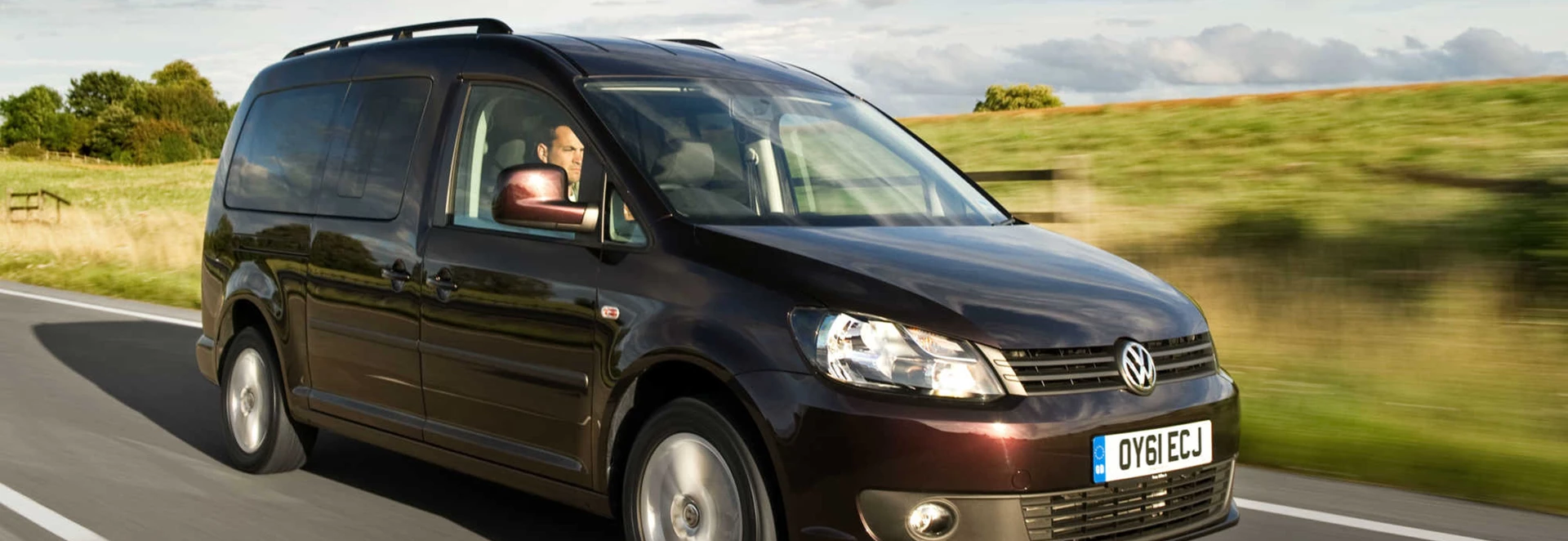The Caddy Life is the MPV version of Volkswagen's Caddy van, based on the last-generation Golf. There are two versions, the larger of which - known as the Caddy Maxi Life - is more than 18 inches longer than the Caddy Life and has a third row of seats, all of them with plenty of room for full-grown adults.
Two diesel engines are available, one a 1.6-litre unit producing 101bhp, the other a 138bhp 2.0-litre unit. Both come in standard or more expensive but also more economical BlueMotion Technology forms. There is also a choice of manual transmission (five gears in the 1.6, six in the 2.0) or a DSG semi-automatic. All versions sold in the UK are front-wheel drive, though there have been 4x4s in other markets.
Performance
Pure performance is rarely a priority for family motors like the Caddy Life. It has a large frontal area, which means there's a lot of air resistance, and neither of the engines is especially powerful. Even the 2.0-litre can't make the car accelerate the car from 0-62mph in under 10.6 seconds, and the 1.6 Maxi with the automatic direct-shift gearbox (DSG) takes 13.5 seconds. Top speeds range from 105 to 116mph. But if this is the kind of vehicle you want, performance is probably quite low down on your list of priorities.
DSG is useful for disabled drivers, or those who simply don't want the inconvenience of having to use their left legs, but it adds more than £1,500 to the price and slightly harms the performance and fuel economy. You would have to be a big fan of DSG to pick it ahead of the manual gearbox.
Ride and Handling
The major controls are light and easy to use, and the seating position is quite car-like.
The Caddy Life is more satisfying to drive than you might imagine. It's not sporty in the least, and the Maxi requires care when reversing (it's almost exactly 16 feet long, after all), but with one or two people on board, rather than five or seven, it can be quite perky on twisty country roads. The major controls are light and easy to use, and the seating position is quite car-like. Even if you have no previous experience of vans, you should settle in to driving the Caddy Life almost immediately.
Interior and Equipment
Most improbably, there was once a Carrera Cup Edition of the Caddy Life, but only 250 were built and they were all sold in Sweden.
Luggage capacity in the standard car is 750 litres with all the seats up and 2,852 litres with the rear ones folded down. These are good figures, but those of the Caddy Life Maxi are spectacular. Its load volume is 530 litres (not including various extra storage spaces) even with seven people on board, and when converted into a two-seater its potential load space rises to a phenomenal 3,900 litres. You could almost live in it. Access (through sliding doors) to the third-row seats in the Maxi is very easy and does not involve clambering over the ones in front. Both versions have an enormous amount of headroom. Even in the front, where there's a large storage compartment above the occupants, they're not going to ruffle their hair on it unless they're exceptionally tall. Rear passengers have no such obstruction and could almost be transported while they're still standing up, though we wouldn't recommend that you try this. The tailgate opening is enormous, taking up almost the entire height and width of the car. The door itself, when open, is above the level of the roof, but there's a strap to allow shorter people to close it again.
Cost
Pricing for the VW Caddy Life starts just below £20,000. Most of the models in the range cost over £20k and the most expensive will set you back by a little over £25,000.
As with the performance, the fuel economy and CO2 emissions are compromised by the car's size. The best figures are 54.3mpg and 136g/km for the 1.6-litre Maxi BlueMotion Technology (BMT isn't available in short-wheelbase models) while the worst are 44.8mpg and 166g/km for the 2.0-litre Maxi with DSG. Vehicle Excise Duty will therefore cost you between £130 and £205 annually, while the BIK rating is not, and probably never will be, less than 22%. In the case of the 2.0 Maxi DSG it will be above 30% from April 2015, and it's very unlikely that it will come below that in the future. It's also worth noting that filling up either vehicle with lots of passengers and luggage, for which there is a great deal of opportunity, will make any of the economy figures mentioned above an unattainable dream. Pricing for the VW Caddy Life starts just below £20,000. Most of the models in the range cost over £20k and the most expensive will set you back by a little over £25,000. That's comparable with a decent family hatchback, and if you can do without DSG and don't need seven seats you can get change out of £24,000.
Our Verdict
Like several other manufacturers, Volkswagen has saved itself a lot of bother by simply putting extra seats and windows into a van rather than developing a new MPV from scratch. It has done this with delightful results. The Caddy Life is attractive in a boxy sort of way, good fun to drive and immensely practical. The performance and running costs aren't great, but on the flip side you can carry a huge amount of stuff, and passengers get the space, if not the ambience, of a limousine. For some people, this can be, to use a well-worn phrase, be all the car they need.




